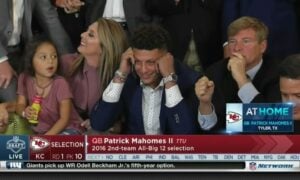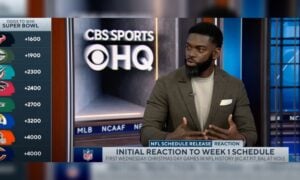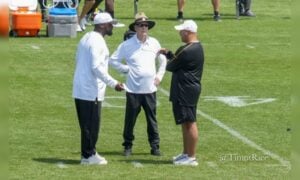While writing about new punter Brad Wing’s chances of becoming the regular punter for the Pittsburgh Steelers, and the comments regarding him made by team general manager Kevin Colbert at the NFL Combine, I also touched on the topic of underclassmen and maturity levels, and I think it’s worth further comment.
With the news that a record number of underclassmen have declared for the 2014 NFL Draft, it makes me wonder how many more players there will be like Brad Wing. Colbert described this class as one of the most talented that he’s ever seen, but also has the potential to be the most immature, with a high level of ‘bust-ability’, thanks to the near-triple-digit influx of underclassmen involved.
I find this quite interesting, because it could change the dynamics about how this whole system works, both on the college and professional levels.
Should we find no unusual adaptability struggles among underclassmen, as discussed in the future viability test, then one would naturally assume that it would only further encourage each end of the chain, resulting in both underclassmen to declaring early for the draft, as well as teams more willing to take the chance to draft them.
Outside of the value of education, which studies suggest is often still a farce when it comes to revenue-producing college athletics, the noble student-athletes of today are finding less and less reason to actually stay in school.
Rather than live off academic scholarships while fearing repercussions for exchanging autographs or memorabilia for money or other services, many of these young athletes—a large portion of which come from financially unstable backgrounds, it should be noted—are quickly realizing that it would behoove them to jumpstart their professional careers by entering the draft as early as possible.
How much longer can the NCAA sound the clarion call of tradition by using the sanctimonious ideal of the ‘student-athlete’ in order to justify the forbidding of these students from in any way profiting from their own athletic success? That is, of course, all the while hypocritically generating millions off their likeness in jersey sales college football-themed video games.
Should the college ranks prove, or continue to prove, the viability of young underclassmen and their readiness for a professional life, the pressure could help force the hand of the NCAA by adding concessions that benefit the players.
Foremost, and most pertinent to the topic, could be greater access to their own futures by reducing the age limit on draft eligibility. As it currently stands, and as it has stood since 1990, a player must be three seasons removed from high school in order to be considered draft-eligible. The requirements prior to 1990 were even more restrictive.
The system in place is great for the NCAA, which is allowed to maintain continuity and thus viability among college programs, and stretches out the earning period for selling player merchandise. It’s also great for the NFL, which is able to pass on the maturation process to the colleges and gives them the opportunity to scout players against a more sustained quality of competition, as well as a free minor league system.
It’s not so great for the players. Granted, only a small portion of college players will ever even make it to an offseason roster, and a vastly smaller portion of players are draft-ready after their first or second season of college ball.
So the sample size that this could affect, at least for the time being, is quite small when speaking about the broad scope of college athletics. But with nearly 100 underclassmen declaring for this draft, among them, how many could have gotten their career off to an earlier start? Or in past years, for that matter?
Why not leave it up to general managers and team scouts to decide when a college athlete is physically, mentally, and emotionally ready to begin their professional careers? After all, it is their job to make these decisions. They’re the ones taking the risks, putting their jobs on the line. They don’t want to make mistakes.
Instead, we have a conspiratorial agreement between the NFL and the NCAA to prevent these ‘student-athletes’ from benefiting from their own performance for three years. It may be easier to do right now, with so many questions still unanswered about the quality and quantity of underclassmen declaring for the draft.
But if athletes continue to be more and more prepared at a younger age, it may only be a matter of time before this issue must be addressed, perhaps even in the court room, as Maurice Clarett once attempted, and as some believe Johnny Manziel could have achieved.







